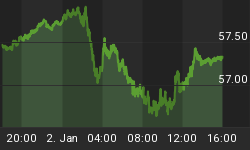The first round of American sanctions against Iran began this week following a 90-day wind-down period, with the second round to hit in November following a 180-day wind-down meant to allow businesses to wrap up or termination operations in the country.
The first round of sanctions bans purchase or acquisition of U.S. bank notes by the Iranian Government as well as limitations on Iran’s trade in gold, precious metals and automobiles. The second, and bigger, phase will kick off on Nov. 5 and will target Iran’s all-important oil and gas industry.
And now Iranians are responding to the crisis by trading off the greatly weakened rial--down 70 percent since May--to purchase gold and, ironically, the U.S. dollar.
USD vs. Rial Exchange Rate (Unofficial)

(Click to enlarge)
Source: Bonbast
Weakened Economy
According to reports by Bloomberg, the gold markets in Tehran were packed with people trying to trade in their near-worthless rials for gold on the day the sanctions went into effect and having a hard time finding exchange centers willing to accept rials. Related: Emerging Markets Hit Hard By Fed’s Trillion Dollar Experiment
Iran’s sanctions could not have come at a worse time. A series of past economic sanctions have greatly weakened the economy as well as the national currency. Things took a turn for the worse in May after Trump withdrew the U.S. from the landmark nuclear deal signed by the Obama administration in 2015, thus defying diplomatic intervention.

(Click to enlarge)
Source: Bloomberg
The deal, signed in Vienna with six world powers, saw international sanctions against Iran lifted, allowing it to sell oil and gas, after the country agreed to scale back its uranium enrichment program, and also promised to desist from pursuing nuclear weapons. President Trump has broken the initial accord despite the International Atomic Energy Agency (IAEA) repeatedly reaffirming that Tehran had been meeting its nuclear commitments.
The country has been characterized by absolute chaos over the past few weeks, including a 50 percent surge in prices of crucial food items, power and water shortages amidst growing protests against president Hassan Rouhani’s administration. But bad as things are right now, they are likely to get a lot worse down the stretch.
The mere prospect of the restrictions have caused the rial to crash spectacularly since May. The government’s efforts to stabilize the beleaguered currency by pegging it at a set rate against the greenback badly backfired and only served to speed up its decline.
Related: What Is Vanadium And Why Did Its Price Just Skyrocket?
The real pain is likely to come when the U.S. reimposes sanctions on the Iran’s energy industry—the country’s lifeblood—in a bid to force it to renegotiate the 2015 pact that Trump has termed as “the worst deal ever”.
Record Gold Reserves

(Click to enlarge)
The Iran crisis is a good case study of the role that gold can play during political and economic crises. Gold prices in the country are soaring above fair value even as fiat currency loses value. Demand for gold in Iran is so high that the price of an Emami coin (Iranian gold coin) has climbed nearly 10 percent, despite spot gold prices having crashed about seven percent in the year-to-date.
Meanwhile, Iran’s forex and gold reserves ($133.7 billion) have outstripped those by the United States ($117.3 billion), with the two countries ranked 19th and 20th respectively in terms of global reserves.
By Alex Kimani for Safehaven.com
More Top Reads From Safehaven.com

















